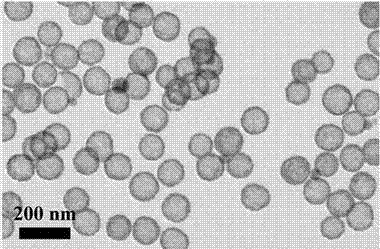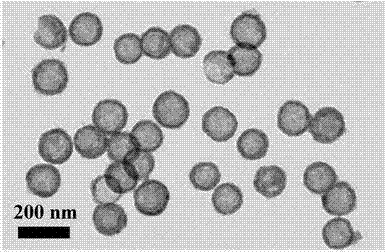Preparation method and application of hollow SnO2@C nanosphere in lithium ion battery
A lithium ion battery, hollow nano technology, applied in nano composite materials and their application fields, to achieve the effects of good dispersibility, large capacity and slowing down agglomeration and pulverization
- Summary
- Abstract
- Description
- Claims
- Application Information
AI Technical Summary
Problems solved by technology
Method used
Image
Examples
Embodiment 1
[0029] Add 60 mL of ethanol, 3 mL of ammonia water and 1 mL of water into a 100 mL flask successively, stir and mix evenly, then slowly add 2.3 mL of tetraethyl orthosilicate (TEOS) dropwise, 20 o C and stirred at constant temperature for 6 h. The resulting solution was centrifuged (7000 rpm, 8 min), washed several times with deionized water and absolute ethanol, and then washed at 50 o C for 10 h. Weigh 1.0 mg of the above oven-dried silica nanoparticles and disperse them in a mixed solution of 3 mL of water and 3 mL of ethanol, and then add 0.24 mL of 0.2 M urea (CH 4 N 2 O) and 0.45 mL 0.08 M sodium stannate (Na 2 SnO 3 ·H 2 O) was added to the above reaction solution, and after stirring for 0.5 h, the mixture was transferred to a 15 mL hydrothermal reaction kettle. 170 in oven o C for 1 h, naturally cooled to room temperature, centrifuged (7000 rpm, 8 min), and then washed several times with deionized water and absolute ethanol, the obtained solid was 50 o C drying...
Embodiment 2
[0032] Add 80 mL of ethanol, 4 mL of ammonia water and 1.3 mL of water into a 100 mL flask successively, stir and mix evenly, then slowly add 3.0 mL of tetraethyl orthosilicate (TEOS) dropwise, 20 o C was stirred at constant temperature for 8 h. The resulting solution was centrifuged (7000 rpm, 10 min), washed several times with deionized water and absolute ethanol, and then washed at 60 o C for 10 h. Weigh 1.5 mg of the above dried silica nanoparticles and disperse them in a mixed solution of 3.5 mL of water and 3.5 mL of ethanol, and then add 0.3 mL of 0.2 M urea (CH 4 N 2 O) and 0.5 mL 0.08 M sodium stannate (Na 2 SnO 3 ·H 2 O) was added to the above reaction solution, and after stirring for 1 h, the mixture was transferred to a 15 mL hydrothermal reaction kettle. 170 in oven o C for 2 h, naturally cooled to room temperature, centrifuged (7000 rpm, 10 min), and then washed several times with deionized water and absolute ethanol, the obtained solid 70 o C dried for 8...
Embodiment 3
[0035] Add 70 mL of ethanol, 3.5 mL of ammonia water and 1.1 mL of water into a 100 mL flask successively, stir and mix evenly, then slowly add 2.0 mL of tetraethyl orthosilicate (TEOS) dropwise, 20 o C and stirred at constant temperature for 7 h. The resulting solution was centrifuged (7000 rpm, 9 min), washed several times with deionized water and absolute ethanol, and then washed at 70 o Dry at C for 8 h. Weigh 1.2 mg of the above dried silica nanoparticles and disperse them in a mixed solution of 3.2 mL of water and 3.2 mL of ethanol, and then add 0.22 mL of 0.2 M urea (CH 4 N 2 O) and 0.4 mL 0.08 M sodium stannate (Na 2 SnO 3 ·H 2 O) was added to the above reaction solution, and after stirring for 0.6 h, the mixture was transferred to a 15 mL hydrothermal reaction kettle. 170 in oven o C for 1.5 h, naturally cooled to room temperature, centrifuged (7000 rpm, 9 min), and then washed several times with deionized water and absolute ethanol, the obtained solid 60 o C ...
PUM
 Login to View More
Login to View More Abstract
Description
Claims
Application Information
 Login to View More
Login to View More - R&D
- Intellectual Property
- Life Sciences
- Materials
- Tech Scout
- Unparalleled Data Quality
- Higher Quality Content
- 60% Fewer Hallucinations
Browse by: Latest US Patents, China's latest patents, Technical Efficacy Thesaurus, Application Domain, Technology Topic, Popular Technical Reports.
© 2025 PatSnap. All rights reserved.Legal|Privacy policy|Modern Slavery Act Transparency Statement|Sitemap|About US| Contact US: help@patsnap.com



